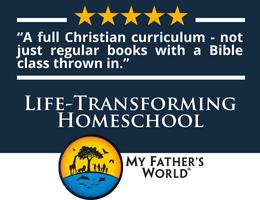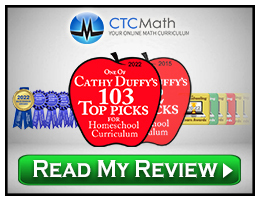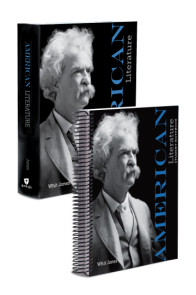Apologia's American Literature, 2nd edition is an impressive high school literature course that can be used in a group class, one-on-one, or for mostly independent study. The course is based on the hefty, 774-page textbook (softcover, Kindle, or Apple book), and you will also need the free lesson plans, tests, and answer keys that are accessed through Apologia's Book Extras website.
The textbook is so large because it contains background and instructional information as well as most of the course readings. Still, students will need to get access to other literary works that are not included either because of their length or copyright issues. They will need to obtain the lengthier works: The Adventures of Huckleberry Finn, The Great Gatsby, The Old Man and the Sea, To Kill a Mockingbird, and A Raisin in the Sun. In addition, they will need to access some twentieth-century poems and short stories.
The course is presented in five units: The Colonial Age, The Age of Reason and Revolution, The Romantic Age, the Age of Realism, and The Modern Age. A lengthy introduction to each unit provides literary, historical, philosophical, and religious background. These introductions, as well as other material throughout the course seem to support a Reformed Protestant point of view. This is especially true for the introduction to the first unit, enough so that other Christians, especially Catholics, might find it problematic. In spite of the heavy-handedness at the beginning of the course, I think it can work very well for Christians of all denominations. While I realize the introductions are important, Catholics and some others might just skip over some sections. The introductions become less of an issue as they move toward the present day where, clearly, non-Christian views are much more of a threat to a Christian worldview.
Worldviews are a major theme throughout the course in a broader sense, considering biblically-based ideas in contrast to others. The worldviews of authors are explored, especially as reflected in their works. Students are often asked to contrast or compare worldview-related topics.
For example, on page 197, one question following a reading from Autobiography by Benjamin Franklin asks, “ From a Christian point of view, clarify what crucial truths about God and man Franklin is leaving out and what experiences in walking with God he is missing.” Another example from page 249 follows the reading from “Federalist No. 51”: ”What do you think about a governmental, economic, or social system being structured to take human weakness and sinfulness into account? Can you defend biblically the idea of letting human sinfulness shape a government or any human system?“
Literary works were selected to reveal “deep truths concerning the human mind and heart, as well as rich beauty, in the works of American literature that you’ll be reading in this course.” Course author Whit Jones further observes that “good literature sometimes needs to shake us up, convict us, make us think hard, and trouble our sleep a bit if it is to help us grow” (p.13).
To that end, the course includes, in addition to the works listed above, others such as “Myths of the Cherokee: How the World Was Made;” “Sinners in the Hands of an Angry God;” “The Declaration of Independence;” excerpts from James Fenimore Cooper's The Deerslayer, Thoreau’s Walden, and Thoreau's “Civil Disobedience;” four poems by Edgar Allen Poe; “The Secret Life of Walter Mitty;” Flannery O’Connor’s “Revelation;” and three poems by Langston Hughes.
Within each unit are a number of chapters, and within each chapter are a number of literary works to be read. In the textbook, the prose literary works are generally reprinted in two columns with a large font size that makes it easy on the eyes. Poems are formatted in a single column. Sidebar columns include definitions of unfamiliar words and explanatory notes that will assist the reader. Each literary work or group of works by a single author has its own introduction. These introductions are very helpful for understanding the author, his or her works, the milieu in which they wrote, and worldview influences, as well as literary genres, styles, and techniques. I must add that I wish the introductions were formatted differently; they have a white font on a brick-red background that I find challenging to read.
The lengthier literary works within the book are each followed by their own sets of questions. Some works, such as two poems by John Greenleaf Whittier, are presented one after the other, followed by a single group of questions. Questions generally begin at a more concrete level dealing with comprehension and simple interpretation. They gradually shift to higher levels of thought.
The number of questions varies greatly. For example, Phillis Wheatley’s “On Virtue” has 12 questions while “The Adams Letters” reading has 40 questions. While many questions are at the comprehension level, a significant number of questions for “The Adams Letters” require at least a paragraph-long response. The novels and the play, “A Raisin in the Sun” each have lengthy lists of questions arranged by chapters or by acts and scenes in the case of the play. This is neither good nor bad, but it indicates that the literary works require varying amounts of time for both reading and responding to questions.
As they answer questions, students are often given pertinent paragraph or stanza numbers to which questions pertain. Sometimes, students are directed to the glossary at the back of the text. For example, on page 301 they are asked to identify the rhyme scheme for “To a Waterfowl,” and the question instructs them to look up “rhyme” in the glossary to be able to answer the question.
The Book Extras include a test for each of the 18 chapters in the course. Chapter tests have short-response questions, a short essay question, and a lengthy essay question.
In addition, students will write two 1500- to 2000-word literary interpretation papers for the course. These are assigned in conjunction with two of the course’s readings, Herman Melville’s “Bartleby, the Scrivener” and Robert Frost’s “Mending Wall.” Extensive instructions in the Book Extras walk students through the writing process. Note that these essay assignments are alluded to in the textbook's introduction and are included in the lesson plans, but they are not mentioned in the textbook and might be easy for parents or teachers to overlook.
As you might have guessed, the course requires a great deal of reading and writing. Parents or teachers are free to skip some of the literary works or some of the questions. They might also use some questions for discussion rather than requiring written responses. However, questions sometimes build upon one another or provide critical learning elements. Jones suggests that if you need to skip written responses to some questions, you might have students read through those questions as well as their answers in the answer key so that they don’t miss anything critical.
Parents or teachers as well as students should read the introduction in the student textbook. Parents or teachers need to also read the “Note to Parents and Teachers” at the beginning of the Weekly Lesson Plans in Book Extras.
The code for accessing the answer key (found within the introductory text) is also visible to students, although they might not have access to the Apologia account through which they can access it. I would not be very concerned about this since most questions require sentences or paragraphs that cannot be copied directly from the answer key without revealing obvious plagiarism.
Summary
I very much appreciate the variety of literary works and the worldview approach used in this American Literature course. In my experience, students find this “deeper meaning” approach to literature more motivating and purposeful than an approach that avoids philosophical or religious implications. Students completing a course such as this are likely to be well-equipped to view other literary works, as well as movies and other media, with a more discerning eye.








